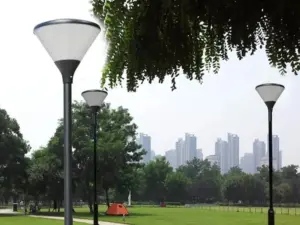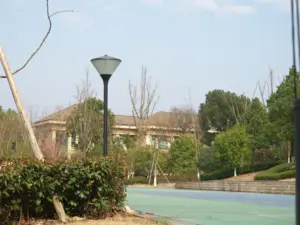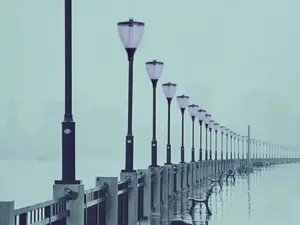Introduction:
Installing garden lights can add a beautiful ambiance to your outdoor space and enhance the overall appearance of your garden. Here’s a step-by-step guide to help you install garden lights.
Before You Begin To Know How To Install Garden Lights

Check Local Regulations:
Before starting any electrical work, ensure you are familiar with local building codes and regulations regarding outdoor lighting installations.
Choose Lighting Fixtures:
Decide on the type of garden lights you want to install. Options include solar-powered lights, low-voltage LED lights or traditional 120V lights.
Create a Lighting Plan:
Walk around your garden during the day and plan your garden lighting installation. Consider highlighting key features like paths, plants, trees, or focal points.
Gather Tools and Materials:
- Installing garden lights and fixtures blueprint (plan)
- Outdoor electrical cables (if required)
- Transformer (for low-voltage systems)
- Connectors, cable staples, and cable connectors
- Screwdriver
- Wire stripper/cutter
- Shovel (if burying cables)
- Waterproof wire nuts or electrical tape
How To Install Garden Lights? A Step-by-Step Guide

Prepare the Lights
If your garden lighting installation requires assembly, follow the manufacturer’s instructions to put them together.
Power Source Selection is Important Before You know How to Install Garden lights
- For solar-powered lights: Choose locations that receive ample sunlight during the day.
- For low-voltage lights: Decide on the location of the transformer. It should be near an outdoor power outlet and protected from the elements.
Install Transformer (For Low-Voltage Systems):
- Mount the transformer on a wall or a sturdy surface near the power outlet.
- Connect the outdoor-rated power cable to the outlet and route it to the transformer. Leave enough slack for easy connections.
- Connect the power cable to the transformer, following the manufacturer’s instructions.
Lay Out the Cables
For low-voltage systems, lay the outdoor electrical cable along your planned lighting path. You can bury it a few inches underground or secure it to the ground with cable staples for better installing garden lights.
Connect the Garden Lights
- For solar-powered lights: Simply place them in their designated locations, making sure they receive enough sunlight during the day.
- For low-voltage and 120V lights: Follow the manufacturer’s instructions to connect each light to the electrical cable using cable connectors or connectors provided with the fixtures. Use waterproof wire nuts or electrical tape to secure connections.
Test the Lights
Before burying the cables (if applicable) or finalizing the installation, test each light to ensure it works correctly.
Secure Cables (For Low-Voltage Systems)
- Once all garden lighting installation connections are tested and working, bury the cables a few inches underground along the planned path.
- Alternatively, secure the cables to the ground with cable staples, keeping them as discreet as possible.
Adjust and Aim the Lights
Position each light according to your lighting plan, adjusting the direction and angle to achieve the desired illumination.
Finalize the Installation
- For solar-powered lights: Ensure installing garden lights is rightly positioned and receive sufficient sunlight during the day.
- For low-voltage and 120V lights: Double-check all connections and make sure the cables are secured.
Turn on the Lights
Once the installation is complete, turn on the lights and enjoy the beautiful ambiance they create in your garden. Remember, if you’re uncertain about How to install garden lights or any part of the installation process, consult a professional electrician to ensure a safe and proper installation.
Is it safe to install garden lights yourself or a Professional should do it?

Installing garden lights can be a rewarding and relatively straightforward DIY project, especially if you choose solar-powered lights or low-voltage systems. However, when it comes to working with electricity, safety should always be a top priority. Whether you should install garden lights yourself or hire a professional depends on several factors:
1. Skill and Experience
DIY: If you have experience with basic electrical work and feel confident handling electrical connections, you may be able to do garden lighting installation yourself, particularly if you’re using solar lights or low-voltage systems.
Professional: If you have limited or no experience with electrical work, it’s best to hire a licensed electrician. A professional will have the expertise to handle electrical connections safely and according to local building codes.
2. Electrical Knowledge
DIY: If you have a good understanding of electrical principles, know how to work with wires and connectors, and can read electrical diagrams, you might feel comfortable handling the installation yourself.
Professional: If electrical work is unfamiliar territory for you, a professional electrician will have the knowledge and expertise to navigate potential challenges and ensure the installation is done correctly and safely.
3. Electrical Codes and Regulations
DIY: If you decide to do it yourself, you must familiarize yourself with local electrical codes and regulations. Outdoor electrical work often has specific requirements to ensure safety and compliance.
Professional: Electricians are well-versed in local building codes and regulations. Hiring a professional ensures that the garden lighting installation meets all safety and legal requirements.
4. Voltage of the Lights
DIY: Solar lights and low-voltage systems (12V) are generally safer and easier to install for DIY enthusiasts. Low-voltage systems are designed to be more user-friendly and carry a lower risk of electrical shock.
Professional: If you plan to install 120V lights or any other high-voltage lighting systems, it is highly advisable to hire a licensed electrician. Working with higher voltages poses a greater risk, and only experienced professionals should handle such installations.
5. The Complexity of the Project
DIY: For simple installations, such as placing solar lights along a pathway, DIY may be appropriate if you have the necessary tools and follow safety guidelines.
Professional: For more complex setups, such as integrating multiple lighting fixtures with a transformer, burying electrical cables, or dealing with higher voltage systems, hiring garden lighting installers is strongly recommended to ensure a safe and reliable installation.
6. Time and Convenience
DIY: Doing it yourself can save money, but it also requires time and effort to research, plan, and execute the installation properly.
Professional: Hiring a professional electrician takes the burden off your shoulders, as they have the knowledge and tools to complete the job efficiently and safely.
Cost To Install Garden Lights
Installing garden lights can be a great way to enhance the beauty and functionality of your outdoor space. Garden lights not only add a touch of elegance and ambiance to your gardens but also provide increased safety and security during the evening hours. However, the cost of installing garden lights can vary based on several factors.
Let’s explore some of the key cost considerations for installing garden lights:
Type of Garden Lights:
The cost to install garden lights can vary depending on the type you choose. There are various options available, including solar-powered lights, LED lights, low-voltage lights, and traditional wired lights. Solar-powered lights tend to be more affordable as they do not require electrical wiring, while LED lights are energy-efficient and have a longer lifespan but might be more expensive upfront.
Number of Lights:
The more lights you install, the higher will be the garden light installation cost. The number of lights you need will depend on the size of your garden and the level of illumination you desire. A larger garden or more elaborate lighting design will naturally require more lights, thus increasing the installation cost.
Quality of Lights:
The quality of the lights can significantly impact the cost. Higher-quality garden lights may be more durable and perform better, but they could come with a higher price tag. It’s essential to balance cost and quality to get long-lasting and efficient lights.
Installation Method:
The way you choose to install the lights can also affect how much to install garden lights. If you opt for solar-powered lights or low-voltage lights, you may be able to handle the installation yourself, reducing labor costs.
Conclusion:
In conclusion, installing garden lights can be safe to do yourself, but it depends on your level of electrical expertise and the complexity of the project. For simple installations like solar lights or low-voltage systems, and if you have the necessary knowledge and skills, DIY can be a viable option.
However, for more complex installations, working with higher voltages, or if you lack electrical experience, it’s best to hire a licensed electrician to ensure a safe and professional installation. Safety should always be the top priority when dealing with electricity, so if you’re uncertain about any aspect of the project, consulting a professional is the best course of action.
